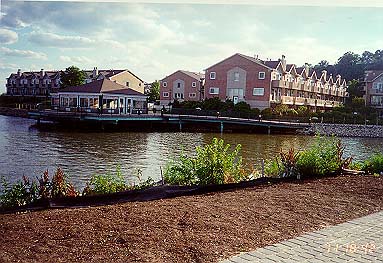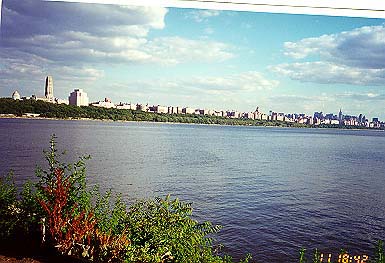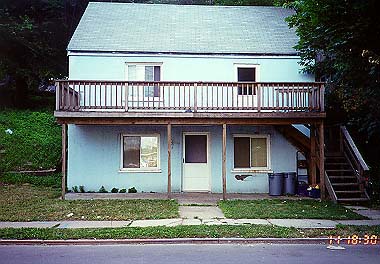
Ann M. Gannon
Professor Julia Keefer
Writing Workshop I, Summer 2000

Others will enter the gates of the ferry and cross from shore to shore,
Others will watch the run of the flood-tide,
Others will see the shipping of Manhattan north and west,
and the heights of Brooklyn to the South and the East,
Others will see the island large and small; Fifty years hence,
others will see them as they cross, the sun half an hour high,
A hundred years hence, or ever so many hundred years hence,
others will see them,
Will enjoy the sunset, the pouring in of the flood-tide,
the falling-back to the sea of the ebb-tide.
Walt Whitman "Crossing Brooklyn Ferry" 1856

Across the Hudson River from the towns of Edgewater and Weehawken are the breathtaking views of Manhattan skyline and its surroundings. The decline in the shipping industry that once was a primary source of use in this area has allowed developers to construct housing which offers the highest economic return along the water front and further up under the cliffs. More than 13 million people in New York and New Jersey live on or near waters that have been sealed off for over a century. For as long as anyone alive can remember, the people of the two states and the great cities and the small towns that surround the waterways of the New York/New Jersey metropolitan area have been cut off from their 800 miles of waterfront.
It is only in the last few years, as the lack of good planning is evidenced by the mess in which most of our cities and suburbs find themselves today, the general public has begun to sense the possibility of reconnection. And it is even more recent that the necessity of preserving the vitality of the waters, open views and stream banks of the Waterfronts has come to be understood.
Unfortunately there are several realities as persistent as the tides. Authority to act is diffused geographically and politically. Major policy and regulatory issues are being revisited. An extraordinary number of waterfront sites are losing to development, and in our highly charged market-driven time opportunities to expand in these areas are choking our communities almost as rapidly as they are being identified.
We are now being presented with numerous opportunities to realize significant public amenities, to restore the health of the waterfronts, and to enhance the economic prospects of people alive today and for generations to come. Such an agenda requires a concerted effort that is immediate, aggressive and sustained. Furthermore, the decrease in preservation of open space, small town characteristics and view corridors in the Edgewater/Weehawken is evident due not only to weak planning but inadequate community participation in opposing further waterfront developments.
My major contribution to this project is to examine Waterfront Development and the lack thereof as it has impacted upon the environment and communities specifically (or as illustrated on photographs and maps) on riverside views and open corridors. The interviews I conducted with Martha Lane, R.A and Cy Richardson, Urban Planner and nearby residents have allowed me to gain insight into these planning matters.
I will demonstrate the use of the sites in Edgewater and Weehawken, NJ and Brooklyn Heights, NY would not only serve private-for-profit uses, but also for public purposes as well. Some of the long terms goals for development should include:
Scale historic districts i.e municipal/historic properties
As illustrated in photographs, the tall condominiums currently undergoing construction seem to be totally out of scale with the surrounding neighborhood, but probably have been approved in the belief that they will be of economic benefit. Backers of anything appearing to offer increased economic development seem to by saying, "build a lot, build it high, and build it dense." No matter what the outcome of these benefits, existing longtime residents in the communities of Edgewater and Weehawken have become increasingly appalled by the outcome of these growths.
The loss in this situation is the potential of blocking the harbor view from these existing homes behind the condominiums, in spite of them being located on the hillside. Obviously there are no height limitations, the zoning laws are limited, other than some height control along the waterís edge and a "requirement for stepping back for the higher portion of a structure"
An understanding of what contributed to these developments on the waterfront can be traced by the combined area of lands owned by both Roseland and Imperatore which is upwards of 150 acres. According to the land use regulations a developer is required to set aside 30% of the development area as common open space. By definition, the development area includes all land, including the Palisades, piers and platforms existing at the time of the developers application, however the development area does not include any land underwater unless the developer has plans for such land to be filled, piered or platformed.
As a resident living close to the waterfront, I can experience the great overcrowding and sore lack of open space. Luckily Weehawken offers not only its residents, but also people from the entire region, an opportunity to stand atop the magnificent Palisades and at least enjoy some serenity and peacefulness of the majestic Hudson River. A weak argument being made by the developers Roseland Properties, is that we will still be able to see the skyline, but as a fellow resident told me, "to take away the frame (the river) from around the picture, would be like putting a hood over the Mona Lisa."
Trying to understand that often progress means change, Iím not completely opposed to development along the waterfront. In fact, I look forward to the time when I can walk along the waterfront to enjoy it from that perspective, as well as from above the cliffs. However, I can only look forward to development which will not impede views of the Hudson River; which will guarantee healthy, public-friendly and usable open space on the waterfront. It should be designed in such a way to alleviate additional traffic burdens on an already overburdened town. It also should be of a scale that will not create an isolated and separate "town" from existing Edgewater/Weehawken, but instead compliment these historically rich and interesting communities.
 The future
of these developments and their impact on the environment can be strengthened
through recognizing the best interests of the total community. How extremely
unfortunate that in general we have regressed into the kind of society, with
a few exceptions, where people have in some way or the other refused to be actively
involved. When people are committed, where they elect good leaders and support
them, planning and all other processes can and do work! Take for example, Portland,
Oregon, now voted one of the best cities to live in America. Most of the credit
can be traced back to a heritage from the early settlers of pride in the environment,
a determination to do things right in their town, and a belief in supporting
a good government.
The future
of these developments and their impact on the environment can be strengthened
through recognizing the best interests of the total community. How extremely
unfortunate that in general we have regressed into the kind of society, with
a few exceptions, where people have in some way or the other refused to be actively
involved. When people are committed, where they elect good leaders and support
them, planning and all other processes can and do work! Take for example, Portland,
Oregon, now voted one of the best cities to live in America. Most of the credit
can be traced back to a heritage from the early settlers of pride in the environment,
a determination to do things right in their town, and a belief in supporting
a good government.
The situation in Edgewater and Weehawken can be compared to the continuous preservation of views from the promenade for residents of Brooklyn Heights. The ongoing controversy between The Port Authority and The Brooklyn Heights Association to implement the zoning restriction called a "scenic view plane" has been upheld for years as a result of continuous community involvement and commitment and a keen interest in protecting the piers and the neighborhood surroundings have succeeded on this side of the water.
Although community groups have prevailed here, Brooklyn is the most populous borough and the most under-served in terms of recreational and open space. Currently only 8.6% of its land mass is in city parks and many of its residents have no open space for activities, yet it has an incredible asset in its waterfront. Perhaps we can learn from our neighboring State and its five boroughs where overcrowding, noise and air pollution are common.
After interviewing with a few longtime Edgewater residents, most were angry and concerned about the crawling traffic during rush hour, which is just about intolerable due to the Lincoln Tunnel and the Ferry Terminal; others were drawn towards the river views. I learned from an active resident that the protected views from the top of the Palisades would be seen only from private backyards, that the planners were ignorant of basic mass-transit impacts that are critical to the developments success, and were unaware that the entire application was before the wrong board (the Zoning Board of Adjustment rather than the Planning Board).
The argument lies in the fact that the communities feel betrayed by the officials they elected, they donít feel they are representing the interests and rights of the people and as a result legal proceedings have to be brought in so the voice of the community can be heard.
Itís time to ask why is a development that is clearly against the interest of Edgewater/Weehawken residents being rushed through? Itís about time these elected officials would wake up and realize what is happening to these waterfronts and itís residents. Changes are needed here to demand a much smaller scale development that is appropriate, with low-rise buildings that reflect the townís existing character and preserve the views, and with a continuous waterfront walkway that will be accessible for recreational use and on-street parking.
Finally if we as individuals take a more active role in our communities through attending zoning board meetings and variance granting processes we can work to curb some of the poor planning before it does more irreparable harm to our communities.
Bibliography
Boyer, M. Christine. Manhattan Manners, Architecture and Style 1850 - 1900.
Rizzoli, New York 1985.
Jackson, J, Kenneth. "CrabGrass Frontier" The Surburbanization of the United States.
Oxford University Press 1985.
Kostof, Spiro. The City Shaped, Urban Patterns and Meanings through History.
Bulfinch Press, 1991.
Murphy, Francis. Walt Whitman: The Complete Poems.
Viking Press, 1990.
Smith, Herber. Planning America's Communities, Paradise Lost, Paradise Found. Planners Press, 1991.
Journal
Curtis, Wayne. (May, June 2000) Belle Epoxy Preservation, pp. 34-36.
Interviews
Cy Richardson, Urban Planner
Martha B. Lane, R.A, Planner
Websites
Brooklyn Heights Association
Landmarks Preservation Commission
NYC Dept of Parks and Recreation
NYC Dept of Environmental Protection
Waterwire.net
Weehawken Waterfront